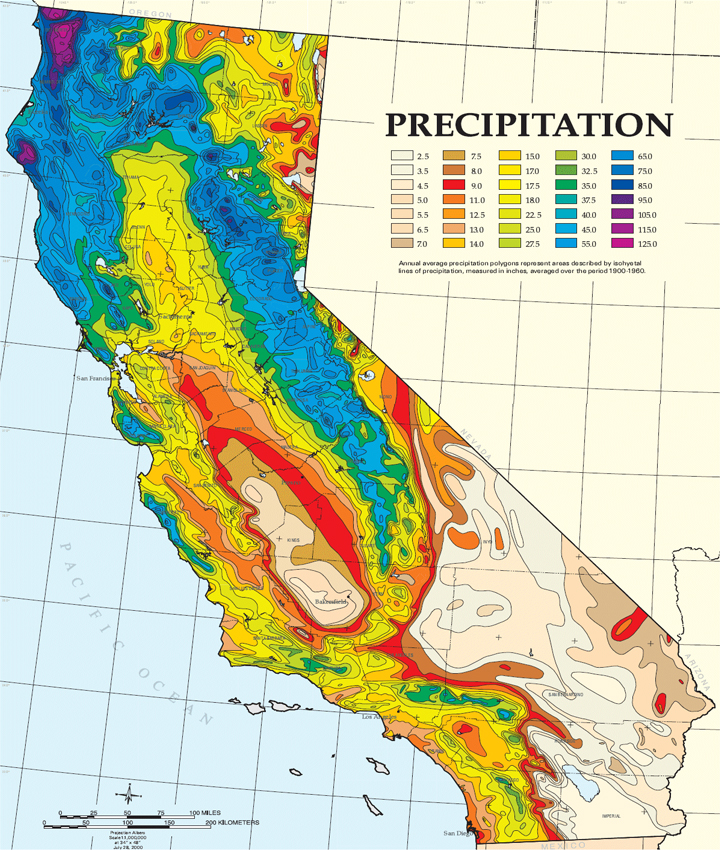|
Section 3: Evapotranspiration [111024 1740] 3.0 Evapotranspiration
This section compares the water needs of an artificial turf ecosystem such as that of Maderas Golf Club, with the region's natural ecosystem, that is, the chaparral. The analysis focuses on the concept of evapotranspiration.
Evapotranspiration (ET) is the amount of water consumed by an ecosystem, expressed in inches per month, and summed up through the year to obtain an annual value. Potential evapotranspiration (PET) is the amount that would be consumed under the assumption of an ample supply of water at all times. Actual evapotranspiration (AET) is the amount that would take place when water is limiting, that is, when there is not enough water to satisfy all the needs of the plants. To simplify ET calculations, the concept of reference crop evapotranspiration, or ETo, is used in practice. Reference crop evapotranspiration is the potential evapotranspiration of an extended surface of 8-15 mm tall green grass cover of uniform height, actively growing, completely shading the ground, and not short of water (Ponce, 1989). The relation between potential evapotranspiration and actual evapotranspiration characterizes the water balance in ecosystems. In humid regions, potential evapotranspiration is usually satisfied and, therefore, actual evapotranspiration is the same as potential evapotranspiration. Conversely, in arid regions, potential evapotranspiration is not satisfied and, thus, actual evapotranspiration is always less than potential evapotranspiration. Irrigation strives to meet the requirements of potential evapotranspiration in an environment where water is limiting. Thus, irrigation amounts to a subsidy; that is, the provision of an additional amount of water to fill in the gap between actual and potential evapotranspiration. With reference to Thompson Canyon, the natural condition is the actual evapotranspiration of the chaparral ecosystem; the artificial condition is the potential evapotranspiration of the warm-season Bermuda grass of the Maderas Golf Club. The ratio of artificial PET to natural AET is an indication of the artificial water demand, that is, of the extent to which the artificial ecosystem affects the sustainability of the region's water resources. 3.1 Mean annual precipitation
The mean annual precipitation for Thompson Canyon was estimated at the intersection of Thompson Creek with Old Coach Road, at Lat. 33o 02' 10" and Long. 117o 0' 58". The isohyetal map prepared by the Fire and Resource Assessment Program (FRAP) of the California Department of Forestry and Fire Protection, shown as Fig. 3.1 (a), was used for this purpose. The geographical detail for San Diego County is shown in Fig. 3.1 (b). The mean annual precipitation at the indicated coordinates, near the basin's center, is P = 13.5 in.
3.2 Evapotranspiration of the natural ecosystem
The Mediterranean ecosystem, commonly referred to as chaparral ecosystem, is prevalent in Southern California. The potential evapotranspiration of the chaparral is 35 in (Hibbert, 1979). Yet the chaparral is conditioned to survive and get by with a much lesser amount of water. In Thompson Canyon, mean annual runoff Q is estimated at 9% of rainfall, that is: Q = 0.09 × P = 0.09 × 13.5 = 1.2 in (Fig. 3.2). Mean annual evapotranspiration is equal to mean annual precipitation P minus mean annual runoff Q: 13.5 - 1.2 = 12.3 in. Note that this AET value is only about a third of the PET (35 in).
3.3 Evapotranspiration of the artificial ecosystem
The potential evapotranspiration of the artificial ecosystem is based on the reference crop.
The reference-crop potential evapotranspiration ETo for San Diego County was obtained from
"Reference Evapotranspiration
Zones" of the California Irrigation Management Information System (CIMIS),
a unit of the [California] Department of Water Resources.
In this study, San Diego County is labeled as Zone 16,
with monthly ETo shown in Table 3.1, and annual ETo =
The Maderas Golf Course features warm-season Bermuda grass for its turf.
The CIMIS crop coefficients Kc
are shown in Table 3.1 ("Converting reference evapotranspiration into turf water use").
The potential evapotranspiration is calculated as:
ETc = Kc × ETo.
Values of ETc are shown in Table 3.1. The
annual ETc is obtained by summing up the monthly values: ETc =
In summary, the annual ETc
for Bermuda grass is 54.2 in (PET), while the annual evapotranspiration for the chaparral
ecosystem is 12.3 in (AET).
Thus, the ratio of potential evapotranspiration
of the artificial ecosystem to actual evapotranspiration of the natural ecosystem is:
| |||||||||||||||||||||||||||||||||||||||||||||||||||||||||||||||||||||||||||||||||||||||||




